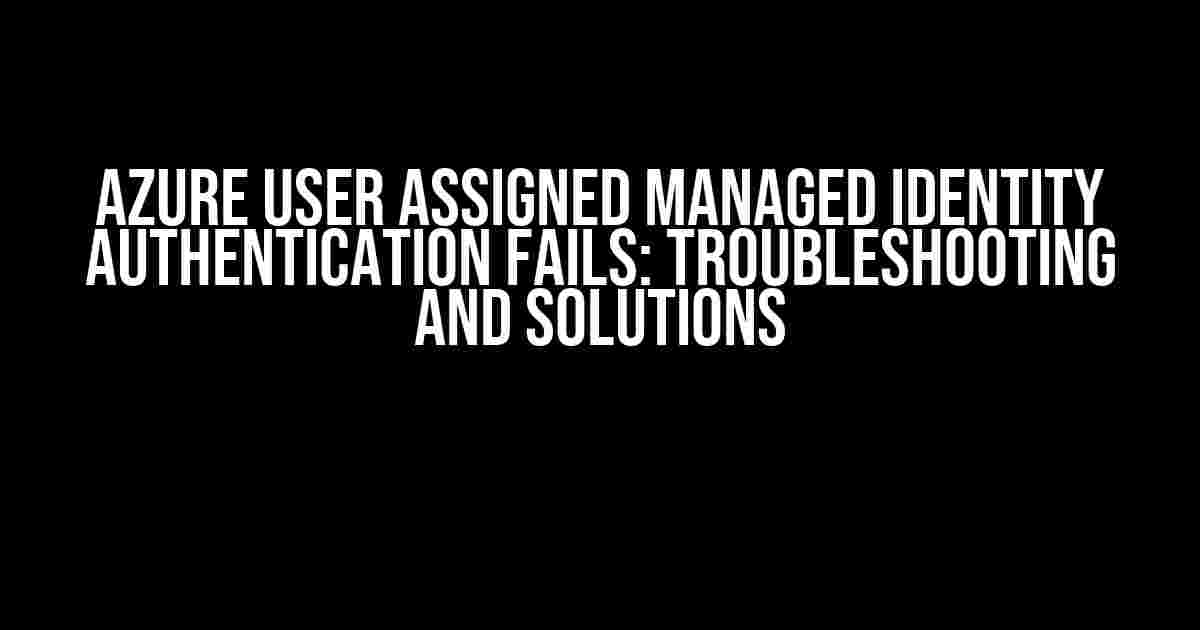Azure user assigned managed identity (UAMI) is a fantastic way to securely authenticate and authorize your applications and resources in Azure. However, when it fails, it can be frustrating and confusing. In this article, we’ll dive deep into the common issues that can cause Azure UAMI authentication to fail, and provide step-by-step instructions on how to troubleshoot and resolve them.
Prerequisites
Before we begin, make sure you have:
- A basic understanding of Azure and its services
- Familiarity with Azure Active Directory (AAD) and its concepts
- Already set up an Azure user assigned managed identity
- Encountered issues with Azure UAMI authentication
Common Issues Causing Azure UAMI Authentication to Fail
Here are the most common reasons why Azure UAMI authentication fails:
1. Incorrect Configuration
Azure UAMI relies on proper configuration to work correctly. Misconfigured settings can lead to authentication failures. Double-check your:
- Identity configuration in Azure AD
- Application settings in Azure portal
- Environment variables and connection strings
2. Permissions and Access Issues
UAMI requires the correct permissions and access to work. Verify that:
- Your application has the necessary Azure AD permissions
- The managed identity has the required roles and access
- The resource you’re trying to access allows UAMI authentication
3. Token Acquisition Failure
Token acquisition is a critical step in UAMI authentication. If token acquisition fails, authentication will fail. Check if:
- Your application is using the correct token endpoint
- The token cache is up-to-date and valid
- Token acquisition is not timing out
4. Network and Connectivity Issues
Network and connectivity problems can also cause UAMI authentication to fail. Ensure that:
- Your application has a stable and secure connection to Azure
- Firewalls and proxies are not blocking the connection
- DNS resolution is working correctly
Troubleshooting Steps
Now that we’ve covered the common issues, let’s dive into the troubleshooting steps to resolve Azure UAMI authentication failures:
Step 1: Verify Azure AD Configuration
Check your Azure AD configuration using the Azure portal or Azure AD Graph Explorer:
// Use Azure AD Graph Explorer to get the managed identity details
https://graphexplorer.azurewebsites.net/?request=https://graph.microsoft.com/v1.0/servicePrincipals/{managedIdentityObjectId}&method=GET
Verify that the managed identity is correctly configured and has the necessary permissions.
Step 2: Check Application Settings and Environment Variables
Review your application settings and environment variables to ensure they are correctly configured:
// Check the Azure portal for application settings
https://portal.azure.com/#@{tenantId}/resource/{resourceId}/overview
// Verify environment variables
echo $AZURE_TENANT_ID
echo $AZURE_CLIENT_ID
echo $AZURE_CLIENT_SECRET
Make sure the environment variables are set correctly and match the Azure portal settings.
Step 3: Inspect Token Acquisition
Use tools like Fiddler or Postman to inspect the token acquisition process:
// Use Fiddler to capture token acquisition requests
https://login.microsoftonline.com/{tenantId}/oauth2/v2.0/token
// Inspect the token acquisition response
{
"access_token": "{accessToken}",
"expires_in": 3599,
"token_type": "Bearer"
}
Verify that the token acquisition request is successful and returns a valid access token.
Step 4: Test Network Connectivity
Use tools like Ping or nslookup to test network connectivity:
// Ping the Azure token endpoint
ping login.microsoftonline.com
// Verify DNS resolution
nslookup login.microsoftonline.com
Ensure that the network connection is stable and DNS resolution is working correctly.
Solutions to Common Issues
Now that we’ve covered the troubleshooting steps, let’s provide solutions to the common issues that cause Azure UAMI authentication to fail:
Solution 1: Update Azure AD Configuration
If you find any discrepancies in the Azure AD configuration, update the settings using the Azure portal or Azure AD Graph Explorer:
// Update the managed identity configuration using Azure AD Graph Explorer
https://graphexplorer.azurewebsites.net/?request=https://graph.microsoft.com/v1.0/servicePrincipals/{managedIdentityObjectId}&method=PATCH
Solution 2: Correct Application Settings and Environment Variables
Update the application settings and environment variables to match the Azure portal configuration:
// Update application settings in the Azure portal
https://portal.azure.com/#@{tenantId}/resource/{resourceId}/overview
// Update environment variables
export AZURE_TENANT_ID={tenantId}
export AZURE_CLIENT_ID={clientId}
export AZURE_CLIENT_SECRET={clientSecret}
Solution 3: Handle Token Acquisition Failures
If token acquisition fails, handle the error and retry the request:
try {
// Token acquisition code
} catch (Exception ex) {
// Handle token acquisition failure
Console.WriteLine("Token acquisition failed: " + ex.Message);
// Retry token acquisition
Thread.Sleep(5000);
// Token acquisition code
}
Solution 4: Resolve Network Connectivity Issues
If network connectivity issues are causing authentication failures, resolve the network problems and ensure a stable connection to Azure.
| Issue | Solution |
|---|---|
| Configure firewall rules to allow Azure traffic | |
| Proxies blocking connection | Configure proxy settings to allow Azure traffic |
| DNS resolution issues | Verify DNS resolution and update DNS settings if necessary |
Conclusion
Azure user assigned managed identity authentication can be complex, but by following the troubleshooting steps and solutions outlined in this article, you should be able to identify and resolve the common issues that cause authentication failures. Remember to:
- Verify Azure AD configuration and application settings
- Inspect token acquisition and handle failures
- Test network connectivity and resolve issues
- Update and correct configuration settings and environment variables
By following these steps, you’ll be able to troubleshoot and resolve Azure UAMI authentication failures, ensuring secure and reliable authentication for your applications and resources in Azure.
Frequently Asked Question
Got stuck with Azure user assigned managed identity authentication? Worry not! Here are some frequently asked questions to get you back on track.
Q1: What are the common reasons for Azure user assigned managed identity authentication failure?
Azure user assigned managed identity authentication can fail due to incorrect configuration, outdated Azure SDK, insufficient permissions, or wrong tenant ID. Make sure to double-check your setup and configurations to avoid these common pitfalls!
Q2: How do I troubleshoot Azure user assigned managed identity authentication issues?
To troubleshoot authentication issues, enable Azure Identity logs, check the Azure Activity Log for errors, and verify the managed identity’s permissions. You can also try using the Azure CLI or Azure PowerShell to authenticate and identify the problem.
Q3: What is the difference between system-assigned and user-assigned managed identities in Azure?
System-assigned managed identities are created and managed by Azure, whereas user-assigned managed identities are created and managed by you. System-assigned identities are tied to a specific resource, whereas user-assigned identities can be reused across multiple resources.
Q4: Can I use Azure user assigned managed identity with Azure Storage?
Yes, you can use Azure user assigned managed identity with Azure Storage. This allows your application to access Azure Storage resources without the need for explicit credentials or keys.
Q5: Are there any restrictions on using Azure user assigned managed identity?
Yes, there are some restrictions on using Azure user assigned managed identity. For example, you can’t use it with Azure Active Directory (AAD) B2C, Azure Functions, or Azure Logic Apps. Make sure to check the Azure documentation for specific restrictions and limitations.


